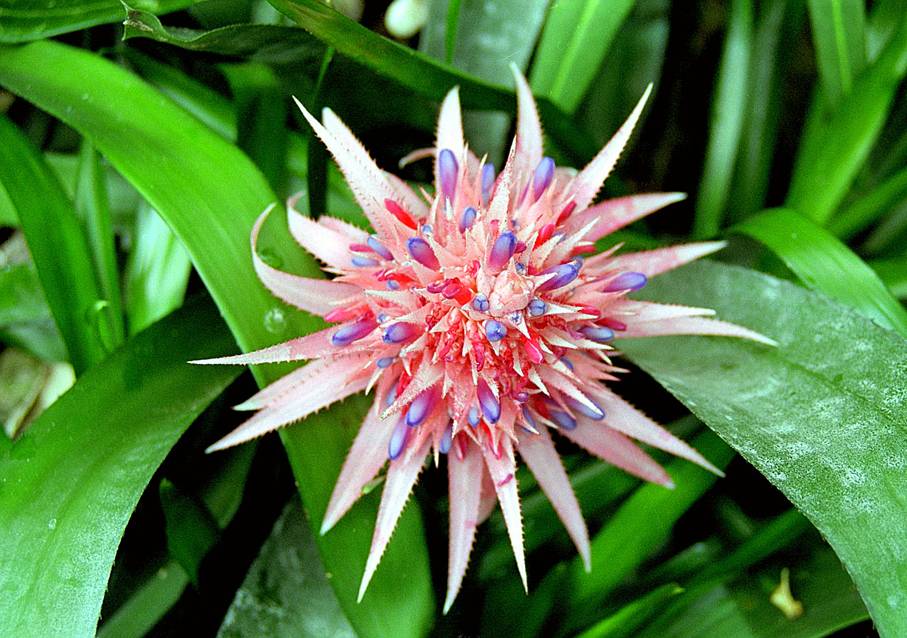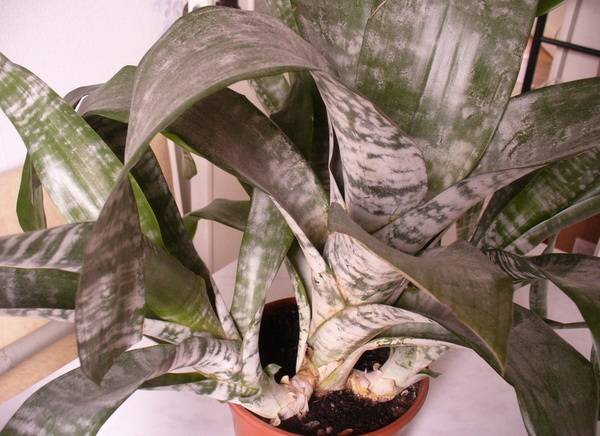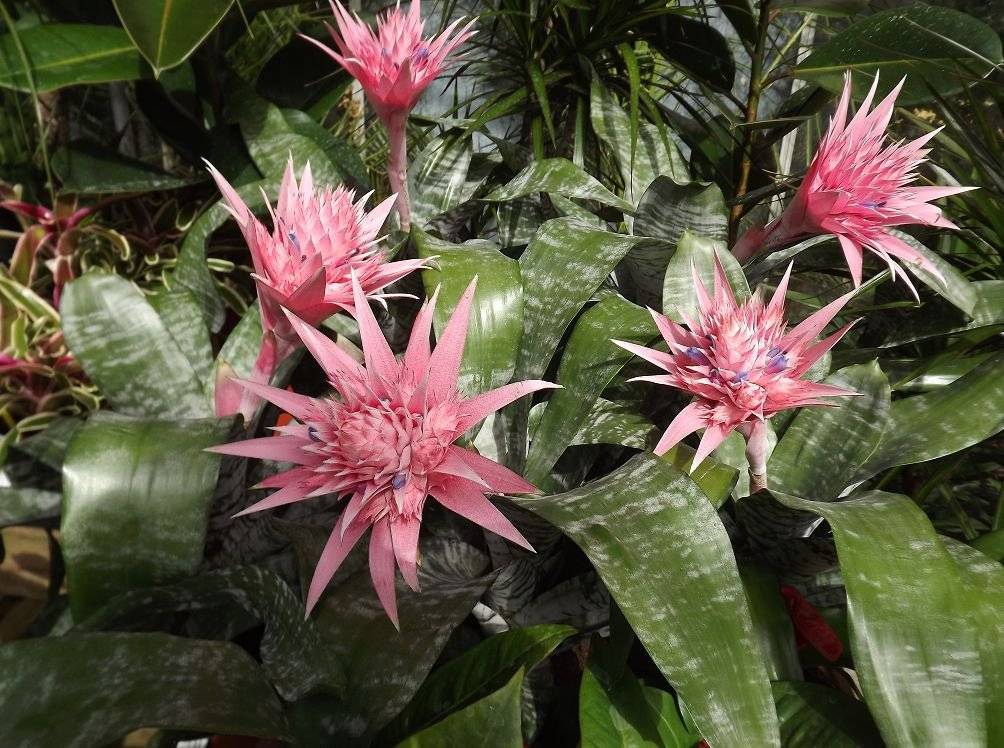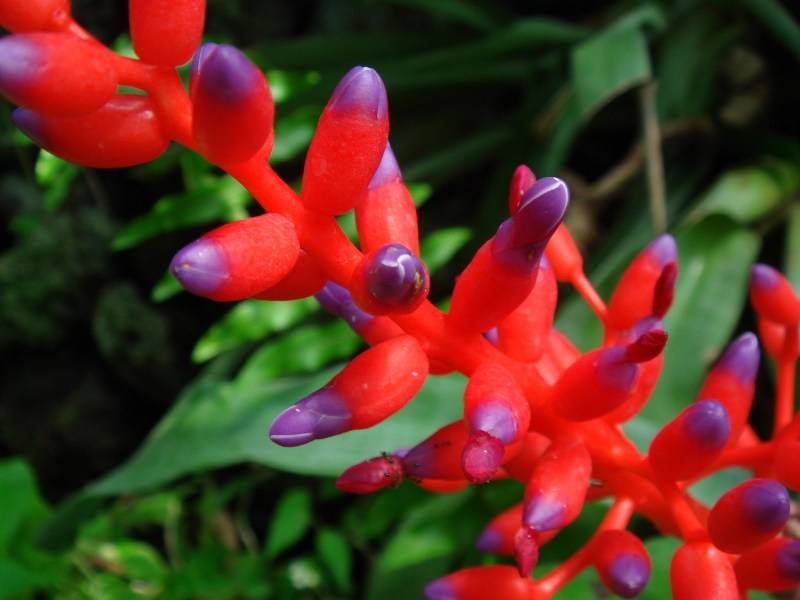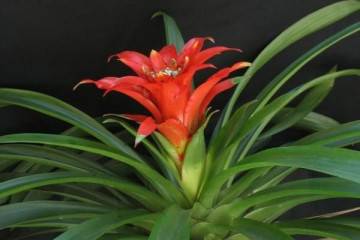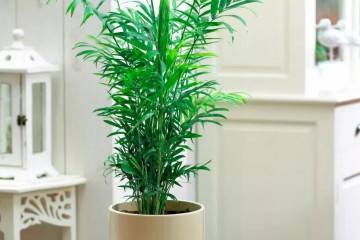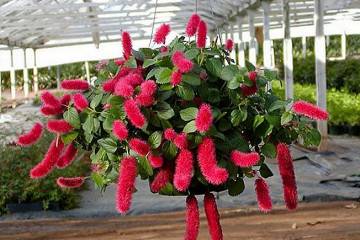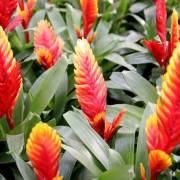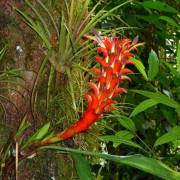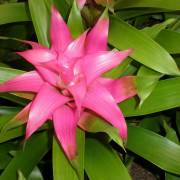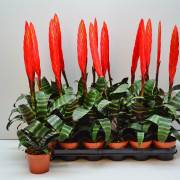Ehmeya flower - care and reproduction at home
Content:
A vibrant and exotic flower often found among breeders and fanciers of unusual plants. Ehmeya is beautiful in itself, but its spectacular flowering is worth it to settle this beauty at home. Moreover, this "lady" is not particularly demanding in leaving.
What does it look like, which family it belongs to
Ehmeya is an epiphyte flower of the Bromyel family, a close relative of pineapple. The homeland of this exotic is South America. In tropical forests, this plant huddles in trees, snags, or in the upper layers of dry foliage.
Tight, belt-like leaves are twisted at the base to create a dense rosette. In nature, such a rosette of leaves creates a bowl for collecting water during rains. This is precisely the nutrition of the plant. The leaves grow up to 50 cm in length. On the edges they are covered with thorns, they can be monochromatic or pockmarked. Ehmeya has about 300 species, with different color of foliage, shape and shades of inflorescences.
Ehmeya: home care
The plant has taken root perfectly in the climate of Russian apartments, it is completely unpretentious in care. You won't have to make a greenhouse out of an apartment, but still, ehmeya will be glad to conditions close to her home.
Temperature
The heat-loving ehmeya lives well in the summer on balconies or open verandas. Temperatures up to 26 ° C will be optimal in summer. During the cold season, it should be about 18 ° C. A drop in temperature to 15 ° C can be detrimental to the flower. This is especially true for varieties with a bright color of foliage, such as striped ehmeya.
The resting period of the plant is not clearly expressed. Ehmeya is in a state of sleep throughout the winter. And all because there are no seasonal temperature drops in her homeland.
Lighting
There should be a lot of light for ehmei. On a hot afternoon, you need to protect the leaves from direct sunlight. In summer, place on windowsills with an east or west direction. With the onset of cold weather, move to the south.
Watering
Proper watering of the plant is the key to its healthy growth and flowering. The higher the temperature, the more water the exotic is needed.
Watering rules:
- With the onset of stable heat, watering should mimic tropical rainfall. You need to use a settled warm water, pouring it directly into the flower outlet and a little into the ground. The only difference from the conditions of wild growth is that excess water must be drained from the outlet after a while. Watering needs frequent, but without stagnation of water in the soil.
- With the onset of cold weather, watering is reduced and only the soil is watered. Watering into an outlet can provoke decay and the development of diseases.
- In winter, it is better to exclude watering altogether, replacing it with spraying.
Spraying
Ehmeya is an epiphyte, which means that its root system serves more as an attachment. And the exotic feeds on its long and wide leaves. Spraying is the main watering for ehmeya.In the autumn-winter months, spraying is reduced, but not completely excluded.
Humidity
Spraying daily creates moisture around the flower. In the summer heat, the pot is placed on a pallet with wet expanded clay or pebbles. Also, for the well-being of an exotic, it is necessary to regularly ventilate the room in which he lives.
Priming
The beautiful ehmei has requirements for the soil - the earth should be light, airy and not retain water. Sod and leafy land in equal parts is the basis for the soil for ehmea. By ½ part of sand and humus, saturate and dilute this mixture. For greater airiness, add bark, pieces of charcoal, sphagnum moss.
Top dressing
Fertilization is also an important factor in growth and flowering. Throughout the summer period, every third watering should be with the addition of top dressing. Special baits for bromyel or potash fertilizers are suitable. Starting in autumn, it is better not to disturb the flower with unnecessary feeding. This can cause a lack of flowering and growth failure.
Is the flower poisonous or not
The plant's toxicity was attributed after an unfriendly meeting with its juice. This must be taken into account when caring for Ehmeya Striped at home. The juice of this particular variety can leave irritations and burns on the skin. Basic care, transplantation and reproduction should be carried out with the protection of the skin.
When and how it blooms
The beautiful ehmeya is loved by breeders because of its exotic flowering. On a massive peduncle, which, like an arrow, rises above the stem, spike-shaped or paniculate inflorescences are formed. Most often, the effect is created more by the bract than the flowers themselves. The bracts are painted in bright red or pink colors, they can have serrations and are much larger than the flowers themselves.
In its natural environment, the duration of flowering in echmea is up to 6 months in a row. At home, small flowers wither quickly. The bract lasts longer, on which the fruit and seed of the flower ripen.
Another feature of the unusual beauty is that the rosette blooms only once. And after flowering, it dies.
Pruning
The plant does not need this procedure. Leaves are the plant's nutritional organ, if healthy leaves are removed, the flower may die.
How does it multiply
Due to the specifics of the echmea, to die after the withering of the flowers, breeders have to reproduce this beauty regularly. This process is simple, children take root easily and quickly.
Propagation by cuttings
Cutting off the stalk for breeding echmea will not work. She has a small stalk that is unable to grow after pruning like this. And the mother plant will die immediately.
Reproduction by layering
Seating ehmeya with layering also will not work. The stem of the plant does not bend and does not take aerial roots for this propagation method. The easiest way to get a new Ehmeya is with its offspring.
Reproduction by shoots
Ehmeya easily reproduces by shoots. After flowering, the mother socket gives birth to babies and dies off. The withering of the mother's outlet is slow, the baby manages to grow and get stronger during this time. The optimal size for separating the daughter rosette from the common root system is 2/3 of the height of an adult plant.
Breeding order:
- The entire flower must be removed from the pot and the soil removed.
- The cut should minimize trauma to the baby's root system.
- The cut site must be treated with activated carbon or crushed chalk.
- Rooting substrate is needed, as for an adult plant.
- Planting pot up to 10 cm in diameter.
- The scion should be covered with a jar or bag and ventilated daily.
- It is important to ensure that the soil is constantly moist, to protect the flower from direct sunlight.
After 20-25 days, it is necessary to check the baby for the presence of root growth. If the young roots have grown, the pot is placed in its new place of growth and fully looked after.
Transfer
A transplant is needed annually to renew the soil and increase the volume of the pot. The pot should not be too deep. A massive bush needs more stability, so width matters here.
During transplantation, it is important not to damage the already small root system. After transplanting for 2-3 days, the flower must be removed in the shade and not watered. Such manipulations will help him get used to the new soil and take root faster.
Possible growing problems
Loss of decorativeness, lack of flowering, diseases and pests appear with improper flower care. Prevention of these problems is with proper care and attention.
Why doesn't the flower bloom
The main reasons for mistakes in flower care:
- lack of lighting and humidity with the onset of active flower growth;
- temperature below 18 ° C and above 35 ° C;
- direct sunlight;
- excessive moistening of the soil, stagnant water can cause a slow process of root decay.
To force the beauty to throw out the peduncle, you must:
- Put apples or bananas, cut into wedges, on moist soil in a pot.
- Create greenhouse conditions for the plant - cover with a bag or glass container.
- The temperature in such a greenhouse should be at least 25 ° C.
- Ventilate regularly and monitor soil moisture.
- As fruit spoils, replace them with fresh ones.
On average, the peduncle appears after 10 days of such resuscitation.
Why do ehmeas turn yellow, dry and fall off the leaves
The main reason for the yellowing of the leaves is a fungal disease. Root rot provokes yellowing, darkening and death of foliage. At this time, the roots of the flower darken and rot. Early diagnosis of the disease helps to save the flower.
It is necessary to remove the bush from the ground, examine the roots and remove all damaged areas. Then transplant into new soil and place in a warm and well-lit place. If the damage was large, you can cut off the upper part of the young shoots, which will save its strength.
Other problems
Improper care provokes a loss of decorative foliage and the appearance of diseases on them:
- When the surface of the leaves begins to dry, this is a sign of a lack of moisture in the air.
- If the leaves wrinkle, then the plant has not been adequately watered. And if, after watering, the turgor of the leaves has not returned to normal, the roots of the plant are damaged. Overflowing water into the ground leads to very rapid decay.
- If the leaves change color, becoming yellow, or their variegated color is discolored, the plant does not have enough lighting.
- If rot has gone along the stem and foliage, it is too late to save the root system. Excess water and low temperatures are the cause of these problems.
Pests
Scabies, mealy and root bugs, and ticks can live on ehmey. It is necessary to remove pests with soapy water, as well as to process greens with special means.
Views
Apartments of Russian florists have populated several decorative species of this exotic. The most common ones are:
- Ehmeya striped or fasciata is a beautiful bush up to 60 cm high. Belt-like leaves are covered with silver transverse blurred stripes. With proper care by experienced breeders, the example echmea (aechmea fasciata) can bloom all summer long. The inflorescence is spherical, large. The bracts are pink, and the flowers change color over time from blue to blue-red.
- Sparkling Ehmeya or Blue Rhine is a small bush with solid light green leaves. The inflorescence of this species is paniculate, covered with a large number of small blue flowers on a coral-red bracts.
- Ehmeya bicolor is considered the most stable and unpretentious to care for. It has an unusual leaf color.The upper part of the leaf is green, and the lower is colored red-violet. Paniculate inflorescences of red-pink color.
- Ehmeya Weilbach - has an unusual transition in color of the leaves. They are reddish green at the base, and the rest of the length is green. Bushes grow up to 50 cm long. Racemes are very bright. The bracts are juicy red, and the flowers are blue with a purple tint.
- Ehmeya tailed or bearded - a small rosette of juicy green color. Paniculate inflorescence with red-orange bracts and golden flowers.
Ehmeya is an unusual and friendly exotic. With its massive appearance and spectacular flowering, it has won the hearts of many flower growers. Ehmeya is undemanding in leaving, adapts well to room conditions. In addition, this flower brings harmony and happiness to the home.
Video

